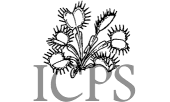|
Carnivorous Plant Newsletter
Volume 35, Number 1, March 2006, pages 12 - 13; Back Cover
New Cultivars
Keywords: cultivar: Drosera capillaris ‘Emerald’s Envy’.
Drosera capillaris ‘Emerald’s Envy’
Submitted: 4 December 2004
In the early 1970s I had infrequent opportunities to visit the Southeastern USA to seek populations of carnivorous plants and to observe them in their natural habitats. On one of these visits I discovered several habitats supporting diverse populations of carnivorous plants growing adjacent to the U.S. Naval Hospital at Pensacola, Florida. Whenever possible I returned to these sites and others to observe any changes human proximity was having on the carnivorous plant populations.
Later, in the 1980s I was able to visit the panhandle of Florida almost annually. This was due to my parents having relocated to Fort Walton Beach, near the Eglin Air Force Base where my father was employed at that time.
A corner lot almost directly across from the hospital was becoming very overgrown by shrubs and trees. Still, there was a great diversity of carnivorous plants struggling to survive in this environment, including Sarracenia alata, Sarracenia purpurea, Sarracenia psittacina, Pinguicula planifolia, and Drosera capillaris. It did not look like they would survive for much longer as they were already nearly buried by the overgrowth.
On my next visit I had a shocking surprise: There was no more overgrowth; in fact there was almost no vegetation at all. A few clumps of grass and scattered colonies of Drosera capillaris were the only vegetation of any kind that remained on the bare earth. From the equipment and materials at this site it appeared it might soon become an asphalt parking lot similar to many others that were already adjacent to it. This was in the early morning on Tuesday, 28 January 1986. In vain I carefully looked over the site to see if any of my other familiar carnivorous plants were still surviving. While doing so I noticed that among the colonies of dark red Drosera capillaris with pink flowers, one colony about a foot in diameter was different. Even though the plants in this colony were growing in full-sun, they were almost entirely green--the tentacles and gland tips were pale pink (see Back Cover). Further still, these plants had white flowers. This was quite a thrill.
I carefully collected only a few mature seed pods, some leaf cuttings from the larger plants, and a few seeds that were just starting to germinate while still inside their wet seedpods. In case I was mistaken about the impending doom of this site I did not wish to be responsible for the extirpation of this wonder from its natural home. I scoured the area for many more hours, but never found similar plants. I have never returned to this site.
About a year later I had managed to grow a very large colony of these plants while I was an undergraduate student of Horticulture at New Mexico State University. While the colony was thriving I harvested a very large quantity of seed and donated most of it to the ICPS Seed Bank, but I also kept some for myself. Subsequently I was unable to continue growing this plant (or for that matter, any carnivorous plants) for several years due to my travels. Eventually, once I was again able to resume my carnivorous plant horticulture hobby I discovered that all my seed of this variety had lost its viability. I sent out a request for seed from anyone who was still growing this material--my appreciation goes to "Sundew Matt" who provided me with viable seed of this interesting plant.
This plant, which I am naming Drosera ‘Emerald’s Envy’, can be distinguished from other Drosera capillaris plants by the following features. The entire leaf petiole and blade exhibit light to medium green coloration, even when grown in strong artificial light or full sunlight. Other Drosera capillaris plants, if grown under low light levels, may appear similarly colored, so it is important to compare only plants grown in high light levels. Furthermore, the flowers of Drosera ‘Emerald’s Envy’ are white--a somewhat unusual color (although white-flowered plants are occasionally encountered in the wild). Mature plants range between 2.5 and 4.0 cm in diameter when grown in strong light, but may be even larger if grown in lower light levels.
Drosera ‘Emerald’s Envy’ may be propagated by seed or vegetative means, but no matter how the plant is propagated, in order to retain the name Drosera ‘Emerald’s Envy’, the progeny must exhibit the light green leaf color, white flower color, and maintain the form of the standard, even when grown under conditions of strong light (including full sun).
Drosera ‘Emerald’s Envy’ is a tender perennial, persisting throughout the year. My current colony (planted among several pots) has been growing continuously since germinating in December of 2000.
I have chosen this cultivar name because the plant is predominantly green as are emeralds, and because I like gems almost as much as I enjoy growing and sharing carnivorous plants.
--- William Joseph Clemens • Tucson , Arizona • USA

Back Cover: Drosera capillaris ‘Emerald’s Envy’. Photograph by William Joseph Clemens.
|

